Prediction of Mechanical Properties of Artificially Weathered Wood by Color Change and Machine Learning
Abstract
:1. Introduction
2. Materials and Methods
2.1. Sample Preparation
2.2. Weathering Test
2.3. Measurement of Color Parameters
2.4. Mechanical Properties
2.5. MC Measurements
2.6. Statistical Analysis
2.7. Machine Learning Analysis
3. Results
3.1. Mechanical Degradation under Artificial Weathering
3.2. Color Change
3.3. MOE and MOR Prediction
4. Discussion and Remarks
5. Conclusions
Author Contributions
Funding
Data Availability Statement
Conflicts of Interest
References
- Feio, A.; Machado, J.S. In-situ assessment of timber structural members: Combining information from visual strength grading and NDT/SDT methods—A review. Constr. Build. Mater. 2015, 101, 1157–1165. [Google Scholar] [CrossRef]
- Palma, P.; Steiger, R. Structural health monitoring of timber structures–Review of available methods and case studies. Constr. Build. Mater. 2020, 248, 118528. [Google Scholar] [CrossRef]
- Machado, J.S.; Pereira, F.; Quilho, T. Assessment of old timber members: Importance of wood species identification and direct tensile test information. Constr. Build. Mater. 2019, 207, 651–660. [Google Scholar] [CrossRef]
- Piazza, M.; Riggio, M. Visual strength-grading and NDT of timber in traditional structures. J. Build. Apprais. 2008, 3, 267–296. [Google Scholar] [CrossRef] [Green Version]
- Ayanleye, S.; Avramidis, S. Predictive capacity of some wood properties by near-infrared spectroscopy. Int. Wood Prod. J. 2021, 12, 83–94. [Google Scholar] [CrossRef]
- Zhou, Z.; Rahimi, S.; Avramidis, S.; Fang, Y. Species-and moisture-based sorting of green timber mix with near infrared spectroscopy. BioResources 2020, 15, 317–330. [Google Scholar]
- Zhou, Z.; Rahimi, S.; Avramidis, S. On-line species identification of green hem-fir timber mix based on near infrared spectroscopy and chemometrics. Eur. J. Wood Wood Prod. 2020, 78, 151–160. [Google Scholar] [CrossRef]
- Ayanleye, S.; Nasir, V.; Avramidis, S.; Cool, J. Effect of wood surface roughness on prediction of structural timber properties by infrared spectroscopy using ANFIS, ANN and PLS regression. Eur. J. Wood Wood Prod. 2021, 79, 101–115. [Google Scholar] [CrossRef]
- Nasir, V.; Nourian, S.; Zhou, Z.; Rahimi, S.; Avramidis, S.; Cool, J. Classification and characterization of thermally modified timber using visible and near-infrared spectroscopy and artificial neural networks: A comparative study on the performance of different NDE methods and ANNs. Wood Sci. Technol. 2019, 53, 1093–1109. [Google Scholar] [CrossRef]
- Stefansson, P.; Thiis, T.; Gobakken, L.R.; Burud, I. Hyperspectral NIR time series imaging used as a new method for estimating the moisture content dynamics of thermally modified Scots pine. Wood Mater. Sci. Eng. 2021, 16, 49–57. [Google Scholar] [CrossRef]
- Riggio, M.; Anthony, R.W.; Augelli, F.; Kasal, B.; Lechner, T.; Muller, W.; Tannert, T. In situ assessment of structural timber using non-destructive techniques. Mater. Struct. 2014, 47, 749–766. [Google Scholar] [CrossRef]
- Beall, F.C. Overview of the use of ultrasonic technologies in research on wood properties. Wood Sci. Technol. 2002, 36, 197–212. [Google Scholar] [CrossRef]
- Van Blokland, J.; Olsson, A.; Oscarsson, J.; Adamopoulos, S. Prediction of bending strength of thermally modified timber using high-resolution scanning of fibre direction. Eur. J. Wood Wood Prod. 2019, 77, 327–340. [Google Scholar] [CrossRef] [Green Version]
- Van Blokland, J.; Adamopoulos, S.; Ahmed, S.A. Performance of Thermally Modified Spruce Timber in Outdoor Above-Ground Conditions: Checking, Dynamic Stiffness and Static Bending Properties. Appl. Sci. 2020, 10, 3975. [Google Scholar] [CrossRef]
- Van Blokland, J.; Nasir, V.; Cool, J.; Avramidis, S.; Adamopoulos, S. Machine learning-based prediction of internal checks in weathered thermally modified timber. Constr. Build. Mater. 2021, 281, 122193. [Google Scholar] [CrossRef]
- Van Blokland, J.; Olsson, A.; Oscarsson, J.; Daniel, G.; Adamopoulos, S. Crack formation, strain distribution and fracture surfaces around knots in thermally modified timber loaded in static bending. Wood Sci. Technol. 2020, 54, 1001–1028. [Google Scholar] [CrossRef]
- Nasir, V.; Nourian, S.; Avramidis, S.; Cool, J. Stress wave evaluation for predicting the properties of thermally modified wood using neuro-fuzzy and neural network modeling. Holzforschung 2019, 73, 827–838. [Google Scholar] [CrossRef]
- Fathi, H.; Kazemirad, S.; Nasir, V. Lamb wave propagation method for nondestructive characterization of the elastic properties of wood. Appl. Acoust. 2021, 171, 107565. [Google Scholar] [CrossRef]
- Fathi, H.; Kazemirad, S.; Nasir, V. A nondestructive guided wave propagation method for the characterization of moisture-dependent viscoelastic properties of wood materials. Mater. Struct. 2020, 53, 1–14. [Google Scholar] [CrossRef]
- Kubovsky, I.; Kristak, L.; Suja, J.; Gajtanska, M.; Igaz, R.; Ruziak, I.; Reh, R. Optimization of parameters for cutting of wood-based materials by CO2 laser. Appl. Sci. 2020, 10, 8113. [Google Scholar] [CrossRef]
- Kubovsky, I.; Kacik, F.; Velkova, V. The effects of CO2 laser irradiation on color and major chemical component changes in hardwoods. BioResources. 2018, 13, 2515–2529. [Google Scholar] [CrossRef]
- Torniainen, P.; Jones, D.; Sandberg, D. Colour as a quality indicator for industrially manufactured ThermoWood®. Wood Mater. Sci. Eng. 2021, 16, 287–289. [Google Scholar] [CrossRef]
- Torniainen, P.; Elustondo, D.; Dagbro, O. Industrial validation of the relationship between color parameters in thermally modified spruce and pine. BioResources. 2016, 11, 1369–1381. [Google Scholar] [CrossRef] [Green Version]
- Ockajova, A.; Kucerka, M.; Kminiak, R.; Kristak, L.; Igaz, R.; Reh, R. Occupational exposure to dust produced when milling thermally modified wood. Int. J. Environ. Res. Public Health 2020, 17, 1478. [Google Scholar] [CrossRef] [Green Version]
- González-Peña, M.M.; Hale, M.D. Colour in thermally modified wood of beech, Norway spruce and Scots pine. Part 1: Colour evolution and colour changes. Holzforschung 2009, 63, 385–393. [Google Scholar] [CrossRef]
- González-Peña, M.M.; Hale, M.D. Colour in thermally modified wood of beech, Norway spruce and Scots pine. Part 2: Property predictions from colour changes. Holzforschung 2009, 63, 394–401. [Google Scholar] [CrossRef]
- Kamperidou, V.; Barboutis, I.; Vasileiou, V. Response of colour and hygroscopic properties of Scots pine wood to thermal treatment. J. For. Res. 2013, 24, 571–575. [Google Scholar] [CrossRef]
- Torniainen, P.; Popescu, C.-M.; Jones, D.; Scharf, A.; Sandberg, D. Correlation of Studies between Colour, Structure and Mechanical Properties of Commercially Produced ThermoWood® Treated Norway Spruce and Scots Pine. Forests 2021, 12, 1165. [Google Scholar] [CrossRef]
- Brischke, C.; Welzbacher, C.R.; Brandt, K.; Rapp, A.O. Quality control of thermally modified timber: Interrelationship between heat treatment intensities and CIE L* a* b* color data on homogenized wood samples. Holzforschung. 2007, 61, 19–22. [Google Scholar] [CrossRef]
- Kamperidou, V.; Barmpoutis, P. Correlation between the changes of Colour and Mechanical properties of Thermally-modified Scots Pine (Pinus sylvestris L.) Wood. Pro Ligno 2015, 11, 360–365. [Google Scholar]
- Todaro, L.; Zuccaro, L.; Marra, M.; Basso, B.; Scopa, A. Steaming effects on selected wood properties of Turkey oak by spectral analysis. Wood Sci. Technol. 2012, 46, 89–100. [Google Scholar] [CrossRef]
- Nasir, V.; Nourian, S.; Avramidis, S.; Cool, J. Classification of thermally treated wood using machine learning techniques. Wood Sci. Technol. 2019, 53, 275–288. [Google Scholar] [CrossRef]
- Johansson, D.; Morén, T. The potential of colour measurement for strength prediction of thermally treated wood. Holz Roh. Werkst. 2006, 64, 104–110. [Google Scholar] [CrossRef]
- Nasir, V.; Nourian, S.; Avramidis, S.; Cool, J. Prediction of physical and mechanical properties of thermally modified wood based on color change evaluated by means of “group method of data handling” (GMDH) neural network. Holzforschung 2019, 73, 381–392. [Google Scholar] [CrossRef]
- Oberhofnerová, E.; Pánek, M.; García-Cimarras, A. The effect of natural weathering on untreated wood surface. Maderas Cienc. Tecnol. 2019, 19, 173–184. [Google Scholar] [CrossRef] [Green Version]
- Timar, M.C.; Varodi, A.M.; Gurău, L. Comparative study of photodegradation of six wood species after short-time UV exposure. Wood Sci. Technol. 2016, 50, 135–163. [Google Scholar] [CrossRef]
- Tomak, E.D.; Ermeydan, M.A. A natural flavonoid treatment of wood: Artificial weathering and decay resistance. Eur. J. Wood Wood Prod. 2020, 78, 1221–1231. [Google Scholar] [CrossRef]
- Srinivas, K.; Pandey, K.K. Photodegradation of thermally modified wood. J. Photochem. Photobiol. B 2012, 117, 140–145. [Google Scholar] [CrossRef] [PubMed]
- Todaro, L.; D’Auria, M.; Langerame, F.; Salvi, A.M.; Scopa, A. Surface characterization of untreated and hydro-thermally pre-treated Turkey oak woods after UV-C irradiation. Surf. Interface Anal. 2015, 47, 206–215. [Google Scholar] [CrossRef]
- Herrera, R.; Arrese, A.; de Hoyos-Martinez, P.L.; Labidi, J.; Llano-Ponte, R. Evolution of thermally modified wood properties exposed to natural and artificial weathering and its potential as an element for façades systems. Constr. Build. Mater. 2018, 172, 233–242. [Google Scholar] [CrossRef]
- Rüther, P.; Jelle, B.P. Color changes of wood and wood-based materials due to natural and artificial weathering. Wood Mater. Sci. Eng. 2013, 8, 13–25. [Google Scholar] [CrossRef]
- Kržišnik, D.; Lesar, B.; Thaler, N.; Humar, M. Influence of natural and artificial weathering on the colour change of different wood and wood-based materials. Forests 2018, 9, 488. [Google Scholar] [CrossRef] [Green Version]
- D’Auria, M.; Lovaglio, T.; Rita, A.; Cetera, P.; Romani, A.; Hiziroglu, S.; Todaro, L. Integrate measurements allow the surface characterization of thermo-vacuum treated alder differentially coated. Measurement 2018, 114, 372–381. [Google Scholar] [CrossRef]
- Reinprecht, L.; Mamoňová, M.; Pánek, M.; Kačík, F. The impact of natural and artificial weathering on the visual, colour and structural changes of seven tropical woods. Eur. J. Wood Wood Prod. 2018, 76, 175–190. [Google Scholar] [CrossRef]
- Teacă, C.A.; Roşu, D.; Bodîrlău, R.; Roşu, L. Structural changes in wood under artificial UV light irradiation determined by FTIR spectroscopy and color measurements–A brief review. BioResources 2013, 8, 1478–1507. [Google Scholar] [CrossRef]
- Müller, U.; Rätzsch, M.; Schwanninger, M.; Steiner, M.; Zöbl, H. Yellowing and IR-changes of spruce wood as result of UV-irradiation. J. Photochem. Photobiol. B 2003, 69, 97–105. [Google Scholar] [CrossRef]
- Cogulet, A.; Blanchet, P.; Landry, V. Wood degradation under UV irradiation: A lignin characterization. J. Photochem. Photobiol. B 2016, 158, 184–191. [Google Scholar] [CrossRef]
- Dong, Y.; Wang, J.A.; Zhu, J.; Jin, T.; Li, J.; Wang, W.; Xia, C. Surface colour and chemical changes of furfurylated poplar wood and bamboo due to artificial weathering. Wood Mater. Sci. Eng. 2020, 1–8. [Google Scholar] [CrossRef]
- Ouadou, Y.; Aliouche, D.; Thevenon, M.F.; Djillali, M. Characterization and photodegradation mechanism of three Algerian wood species. J. Wood Sci. 2017, 63, 288–294. [Google Scholar] [CrossRef]
- Derbyshire, H.; Miller, E.R. The photodegradation of wood during solar irradiation. Holz Roh. Werkst. 1981, 39, 341–350. [Google Scholar] [CrossRef]
- Sharratt, V.; Hill, C.A.; Kint, D.P. A study of early colour change due to simulated accelerated sunlight exposure in Scots pine (Pinus sylvestris). Polym. Degrad. Stab. 2009, 94, 1589–1594. [Google Scholar] [CrossRef]
- Derbyshire, H.; Miller, E.R.; Turkulin, H. Investigations into the photodegradation of wood using microtensile testing. Holz Roh. Werkst. 1995, 53, 339–345. [Google Scholar] [CrossRef]
- De la Caba, K.; Guerrero, P.; Del Río, M.; Mondragon, I. Weathering behaviour of wood-faced construction materials. Constr. Build. Mater. 2007, 21, 1288–1294. [Google Scholar] [CrossRef]
- Del Menezzi, C.H.S.; de Souza, R.Q.; Thompson, R.M.; Teixeira, D.E.; Okino, E.Y.A.; da Costa, A.F. Properties after weathering and decay resistance of a thermally modified wood structural board. Int. Biodeterior. 2008, 62, 448–454. [Google Scholar] [CrossRef]
- Sonderegger, W.; Kránitz, K.; Bues, C.T.; Niemz, P. Aging effects on physical and mechanical properties of spruce, fir and oak wood. J. Cult. Herit. 2015, 16, 883–889. [Google Scholar] [CrossRef]
- Boonstra, M.J.; Van Acker, J.; Kegel, E. Effect of a two-stage heat treatment process on the mechanical properties of full construction timber. Wood Mater. Sci. Eng. 2007, 2, 138–146. [Google Scholar] [CrossRef]
- Tomak, E.D.; Ustaomer, D.; Yildiz, S.; Pesman, E. Changes in surface and mechanical properties of heat treated wood during natural weathering. Measurement 2014, 53, 30–39. [Google Scholar] [CrossRef]
- Persze, L.; Tolvaj, L. Photodegradation of wood at elevated temperature: Colour change. J. Photochem. Photobiol. B 2012, 108, 44–47. [Google Scholar] [CrossRef] [PubMed]
- Nasir, V.; Fathi, H.; Kazemirad, S. Combined machine learning–wave propagation approach for monitoring timber mechanical properties under UV aging. Struct. Health Monit. 2021, 20, 1475921721995987. [Google Scholar] [CrossRef]
- Fathi, H.; Kazemirad, S.; Nasir, V. Mechanical degradation of wood under UV radiation characterized by Lamb wave propagation. Struct. Control Health Monit. 2021, 28, e2731. [Google Scholar] [CrossRef]
- ISO 13061-3. Physical and Mechanical Properties of Wood—Test Methods for Small Clear Wood Specimens—Part 3: Determination of Ultimate Strength in Static Bending; International Organization for Standardization: Geneva, Switzerland, 2014. [Google Scholar]
- ISO 13061-4. Physical and Mechanical Properties of Wood—Test Methods for Small Clear Wood Samples—Part 4: Determination of Modulus of Elasticity in Static Bending; International Organization for Standardization: Geneva, Switzerland, 2014. [Google Scholar]
- Tolvaj, L.; Persze, L.; Albert, L. Thermal degradation of wood during photodegradation. J. Photochem. Photobiol. B 2011, 105, 90–93. [Google Scholar] [CrossRef]
- Feist, W.C. Outdoor wood weathering and protection. Archaeological wood, properties, chemistry, and preservation. Adv. Chem. Ser. 1990, 225, 263–298. [Google Scholar]
- Williams, R.S. Weathering of wood. In Handbook of Wood Chemistry and Wood Composites; CRC Press: Boca Raton, FL, USA, 2005; Volume 7, pp. 139–185. [Google Scholar]
- ASTM D2244-16, Standard Practice for Calculation of Color Tolerances and Color Differences from Instrumentally Measured Color Coordinates; ASTM International: West Conshohocken, PA, USA, 2016.
- ISO 13061-1. Physical and Mechanical Properties of Wood—Test Methods for Small Clear Wood Samples—Part 1: Determination of Moisture Content for Physical and Mechanical Tests; International Organization for Standardization: Geneva, Switzerland, 2014. [Google Scholar]
- ISO 13061-2. Physical and Mechanical Properties of Wood—Test Methods for Small Clear Wood Samples—Part 2: Determination of Density for Physical and Mechanical Tests; International Organization for Standardization: Geneva, Switzerland, 2014. [Google Scholar]
- Mardanshahi, A.; Nasir, V.; Kazemirad, S.; Shokrieh, M.M. Detection and classification of matrix cracking in laminated composites using guided wave propagation and artificial neural networks. Compos. Struct. 2020, 246, 112403. [Google Scholar] [CrossRef]
- Yu, Y.; Dackermann, U.; Li, J.; Niederleithinger, E. Wavelet packet energy–based damage identification of wood utility poles using support vector machine multi-classifier and evidence theory. Struct. Health Monit. 2019, 18, 123–142. [Google Scholar] [CrossRef] [Green Version]
- Ružiak, I.; Koštial, P.; Jančíková, Z.; Gajtanska, M.; Krišťák, Ľ.; Kopal, I.; Polakovič, P. Artificial Neural Networks Prediction of Rubber Mechanical Properties in Aged and Nonaged State. In Improved Performance of Materials; Springer: Cham, Switzerland, 2018; pp. 27–35. [Google Scholar]
- El Kadi, H. Modeling the mechanical behavior of fiber-reinforced polymeric composite materials using artificial neural networks—A review. Compos. Struct. 2006, 73, 1–23. [Google Scholar] [CrossRef]
- Nasir, V.; Cool, J.; Sassani, F. Intelligent machining monitoring using sound signal processed with the wavelet method and a self-organizing neural network. IEEE Robot. Autom. Lett. 2019, 4, 3449–3456. [Google Scholar] [CrossRef]
- Nasir, V.; Cool, J. Characterization, optimization, and acoustic emission monitoring of airborne dust emission during wood sawing. Int. J. Adv. Manuf. Technol. 2020, 109, 2365–2375. [Google Scholar] [CrossRef]
- Nasir, V.; Cool, J.; Sassani, F. Acoustic emission monitoring of sawing process: Artificial intelligence approach for optimal sensory feature selection. Int. J. Adv. Manuf. Technol. 2019, 102, 4179–4197. [Google Scholar] [CrossRef]
- Nasir, V.; Cool, J. Intelligent wood machining monitoring using vibration signals combined with self-organizing maps for automatic feature selection. Int. J. Adv. Manuf. Technol. 2020, 108, 1811–1825. [Google Scholar] [CrossRef]
- Somvanshi, M.; Chavan, P.; Tambade, S.; Shinde, S.V. A review of machine learning techniques using decision tree and support vector machine. In Proceedings of the 2016 International Conference on Computing Communication Control and Automation (ICCUBEA), Pune, India, 12–13 August 2016; pp. 1–7. [Google Scholar]
- Van Blokland, J.; Nasir, V.; Cool, J.; Avramidis, S.; Adamopoulos, S. Machine learning-based prediction of surface checks and bending properties in weathered thermally modified timber. Constr. Build. Mater. 2021, 281, 124996. [Google Scholar] [CrossRef]
- Steinberg, D.; Colla, P. CART: Classification and regression trees. In The Top Ten Algorithms in Data Mining; CRC Press: Boca Raton, FL, USA, 2009; Volume 9, p. 179. [Google Scholar]
- Breiman, L.; Friedman, J.; Stone, C.J.; Olshen, R.A. Classification and Regression Trees; CRC Press: Boca Raton, FL, USA, 1984. [Google Scholar]
- Fathi, H.; Nasir, V.; Kazemirad, S. Prediction of the mechanical properties of wood using guided wave propagation and machine learning. Construct. Build. Mater. 2020, 262, 120848. [Google Scholar] [CrossRef]
- Tolvaj, L.; Faix, O. Artificial aging of wood monitored by drift spectroscopy and CIE Lab color measurements. Holzforschung 1995, 49, 397–404. [Google Scholar] [CrossRef]
- Pandey, K.K. Study of the effect of photo-irradiation on the surface chemistry of wood. Polym. Degrad. Stabil. 2005, 90, 9–20. [Google Scholar] [CrossRef]
- Nzokou, P.; Kamdem, D.P. Influence of wood extractives on the photo-discoloration of wood surfaces exposed to artificial weathering. Color Research & Application: Endorsed by Inter-Society Color Council, The Colour Group (Great Britain), Canadian Society for Color, Color Science Association of Japan, Dutch Society for the Study of Color, The Swedish Colour Centre Foundation, Colour Society of Australia, Centre Français de la Couleur. Color Res. Appl. 2006, 31, 425–434. [Google Scholar]
- Nasir, V.; Sassani, F. A review on deep learning in machining and tool monitoring: Methods, opportunities, and challenges. Int. J. Adv. Manuf. Technol. 2021, 115, 2683–2709. [Google Scholar] [CrossRef]
- Serin, G.; Sener, B.; Ozbayoglu, A.M.; and Unver, H.O. Review of tool condition monitoring in machining and opportunities for deep learning. Int. J. Adv. Manuf. Technol. 2020, 109, 953–974. [Google Scholar] [CrossRef]
- Yang, J.; Li, S.; Wang, Z.; Dong, H.; Wang, J.; Tang, S. Using Deep Learning to Detect Defects in Manufacturing: A Comprehensive Survey and Current Challenges. Materials 2020, 13, 5755. [Google Scholar] [CrossRef]

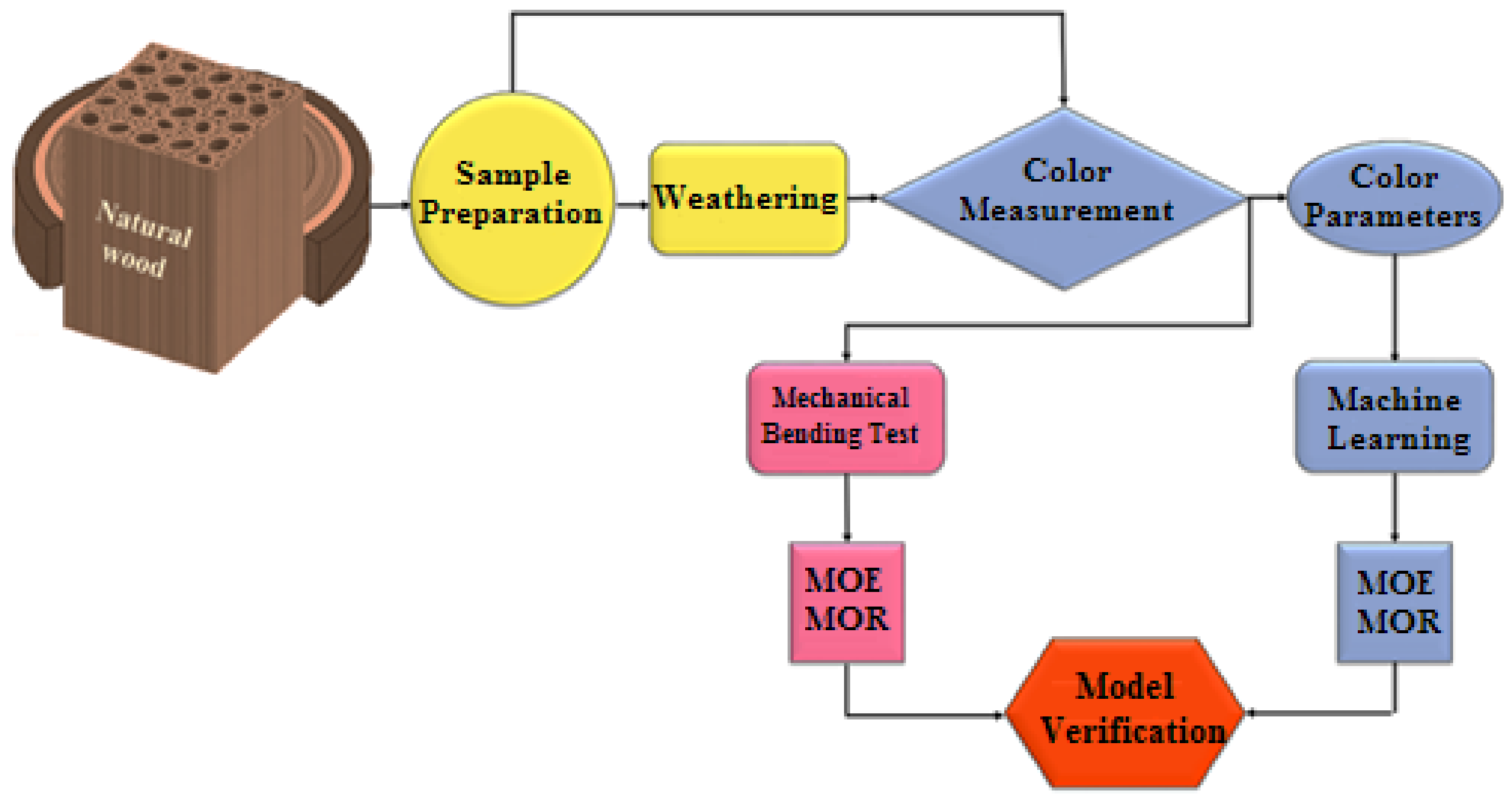
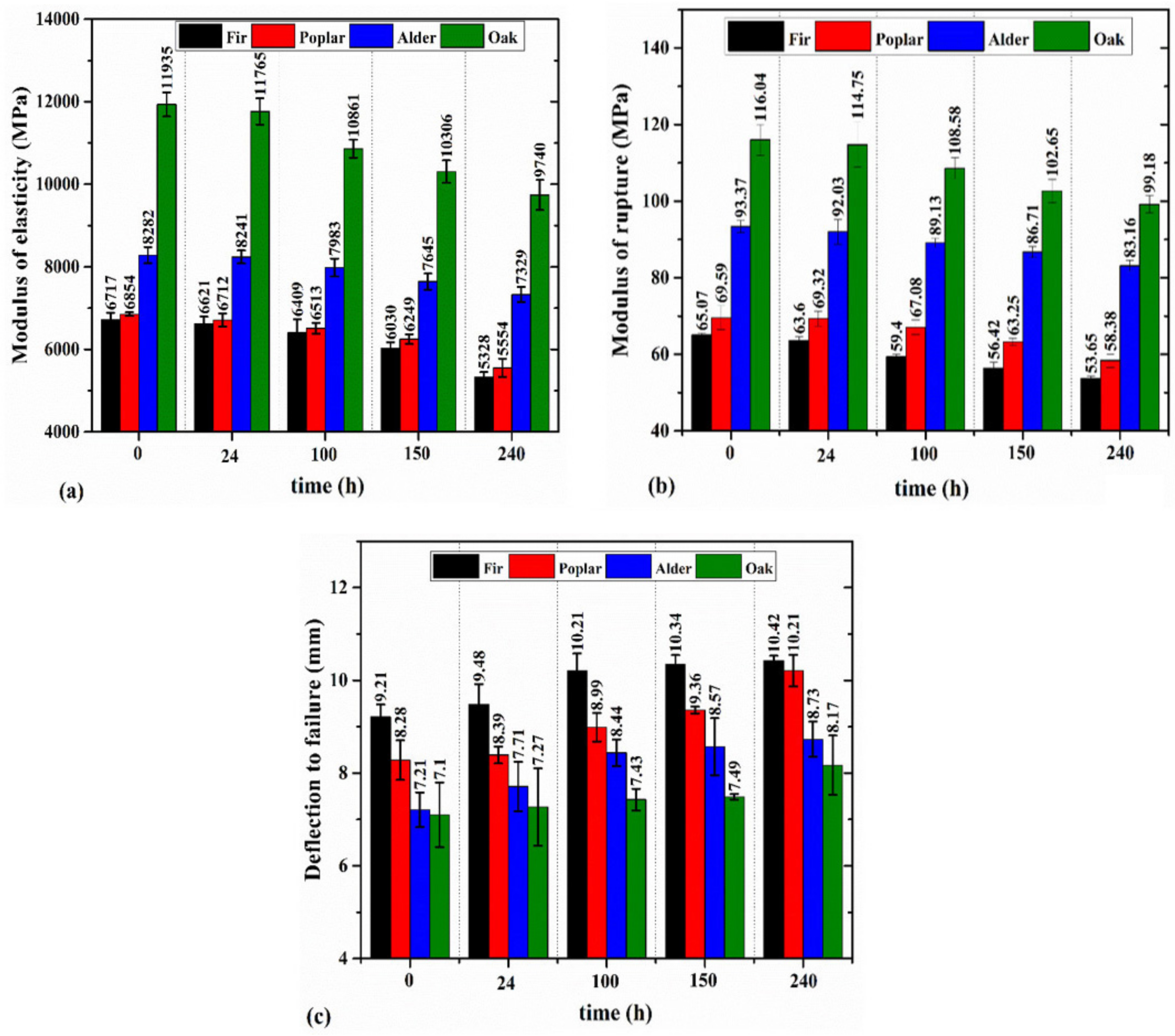
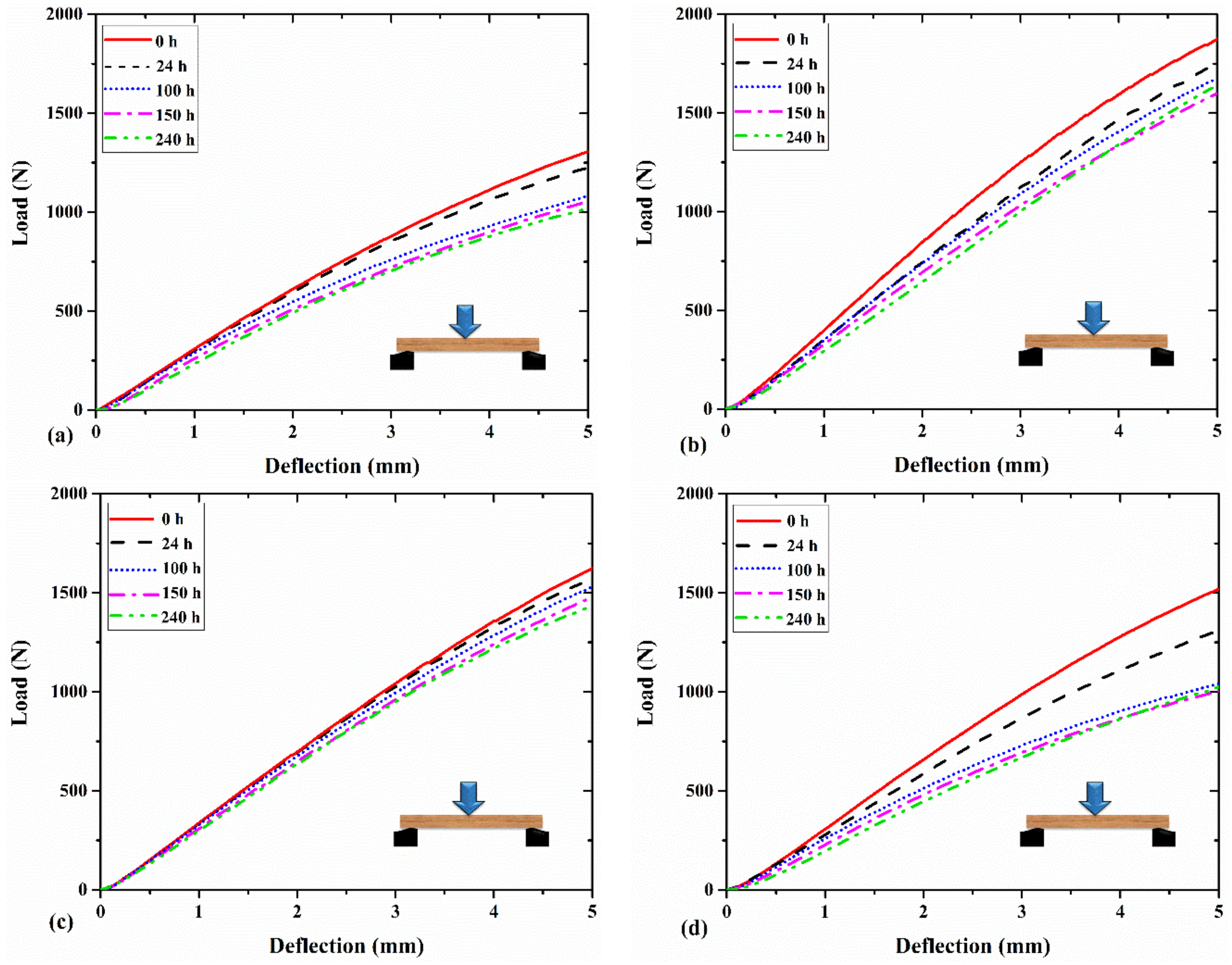


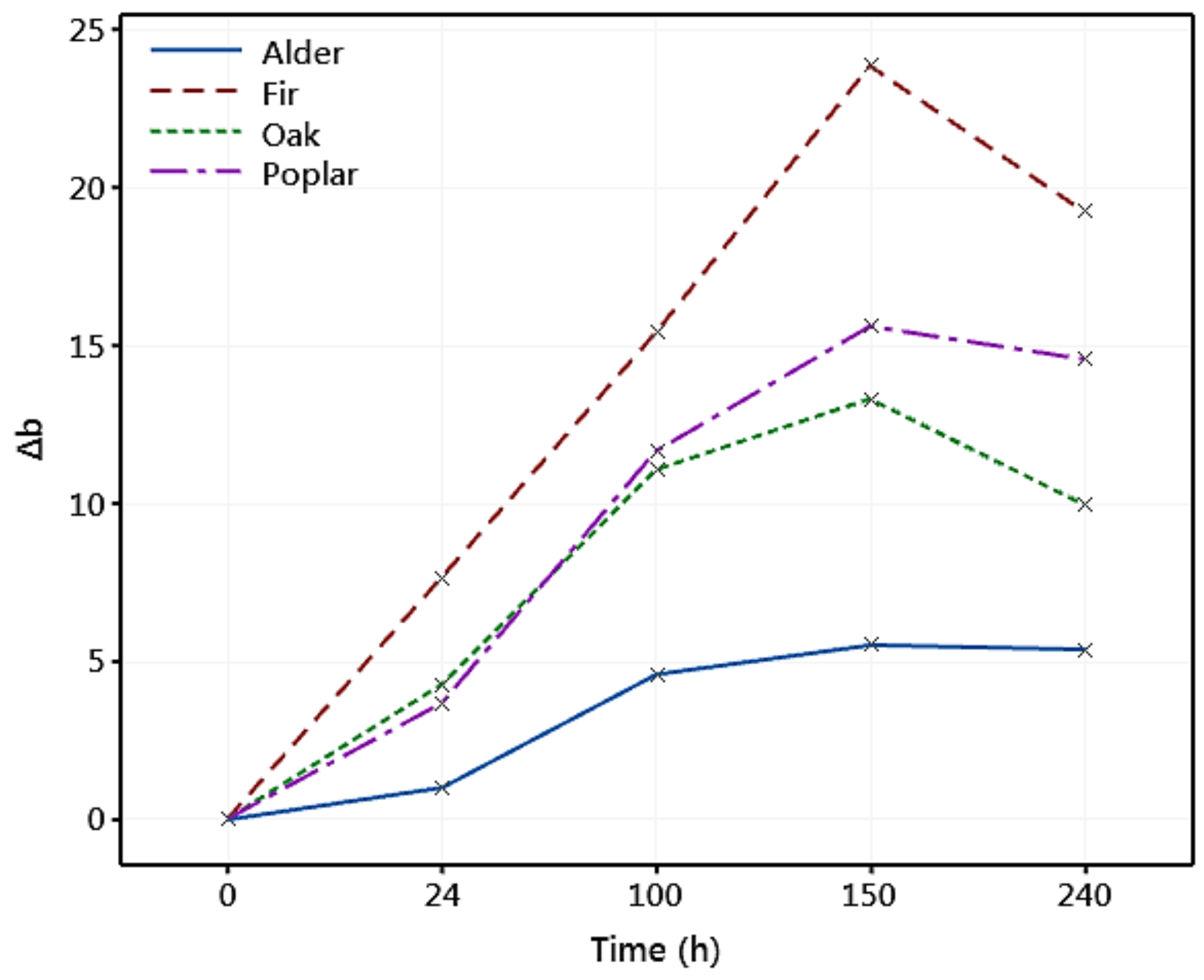
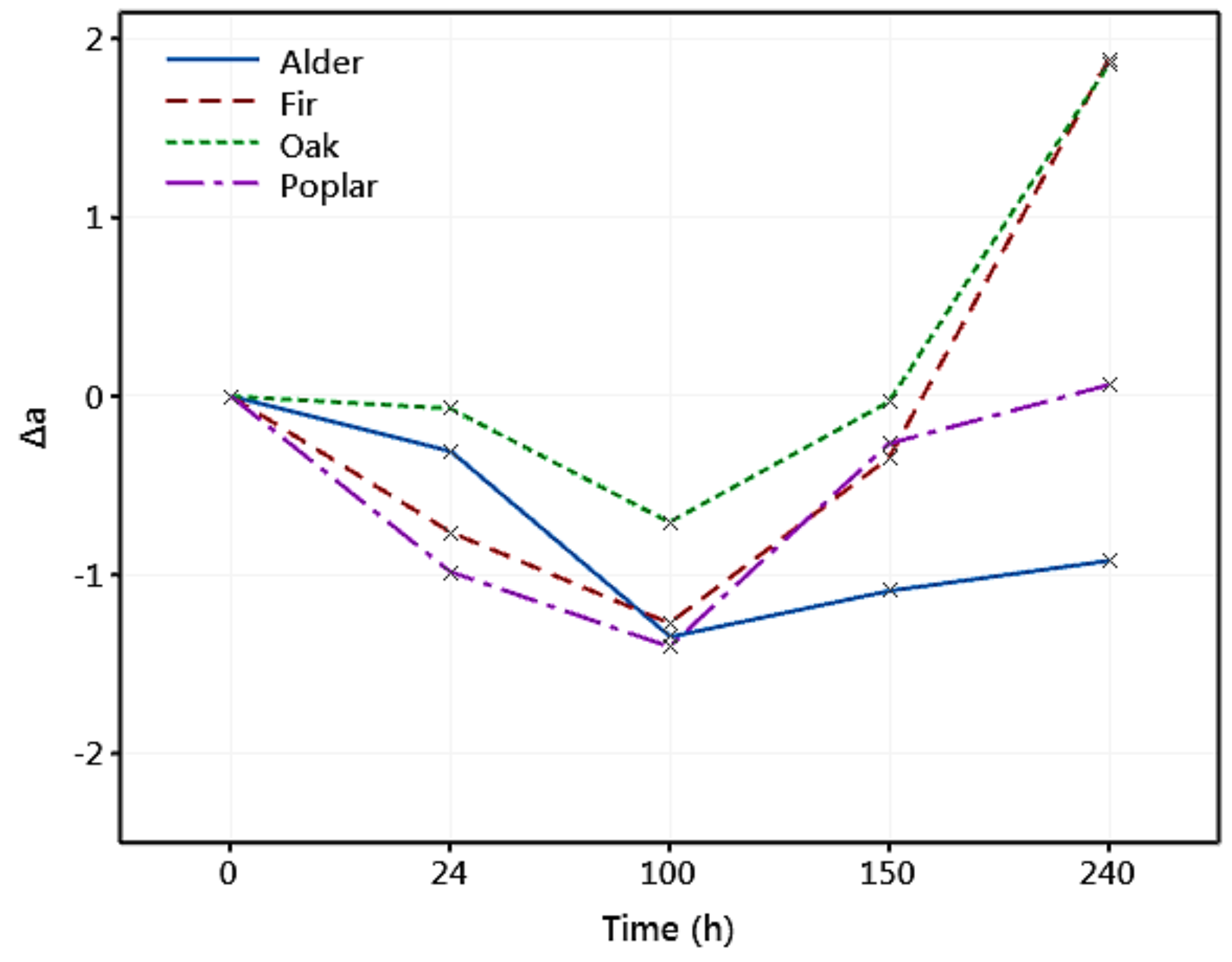
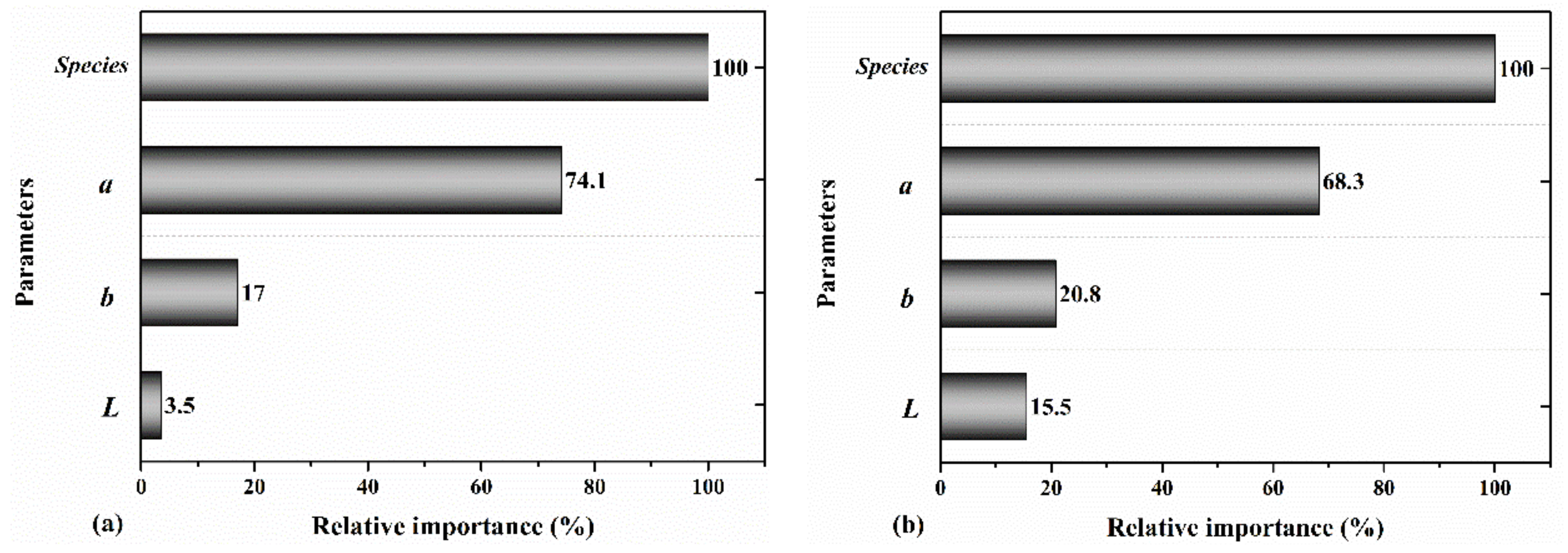
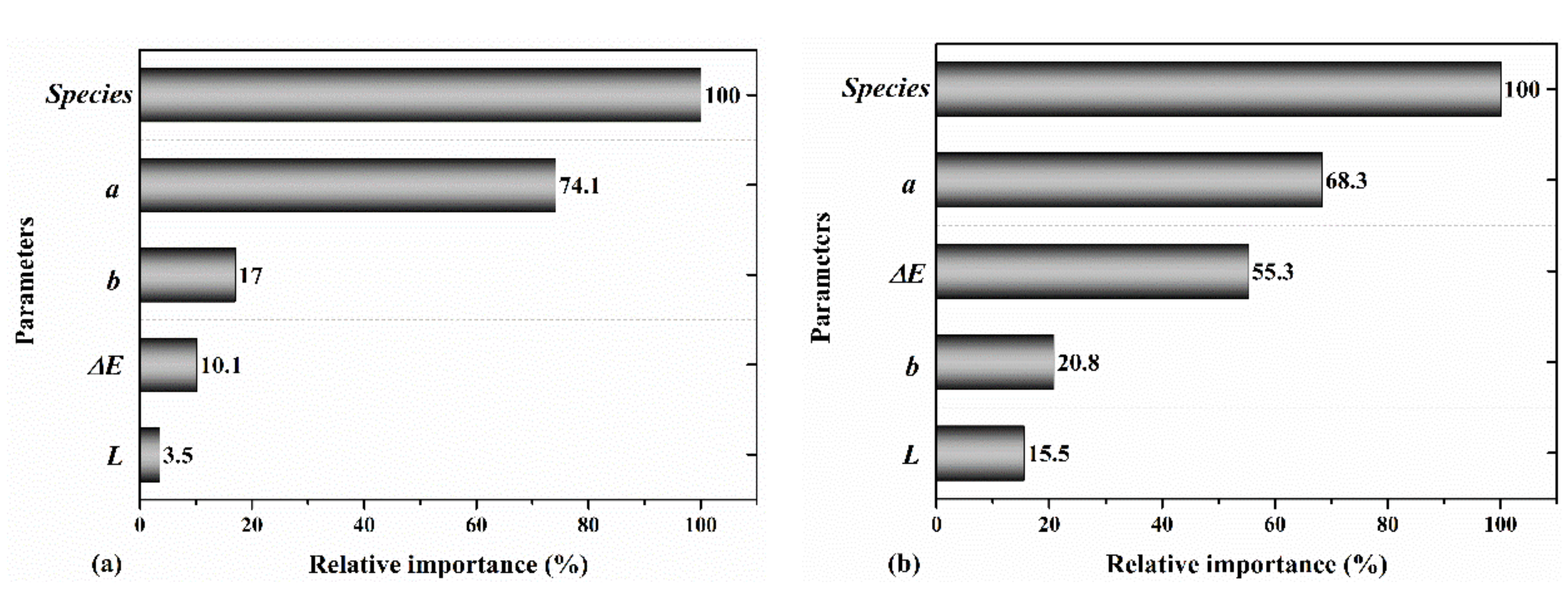
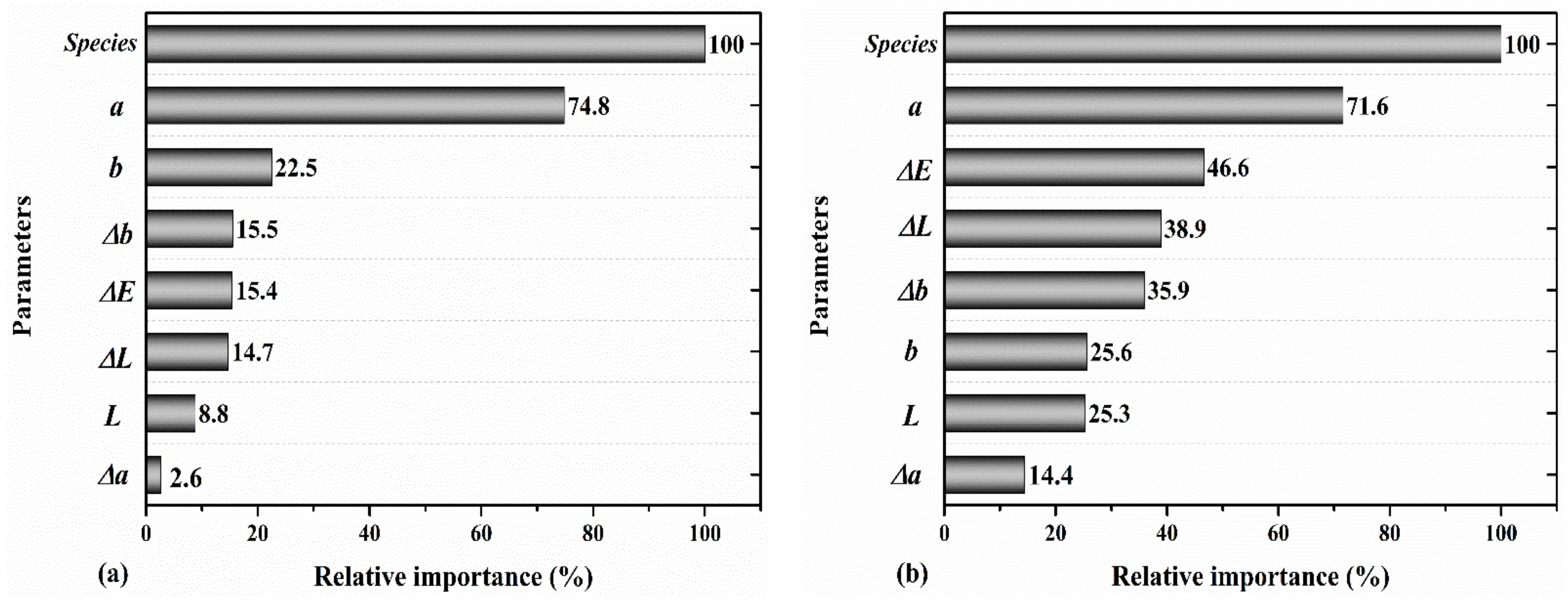
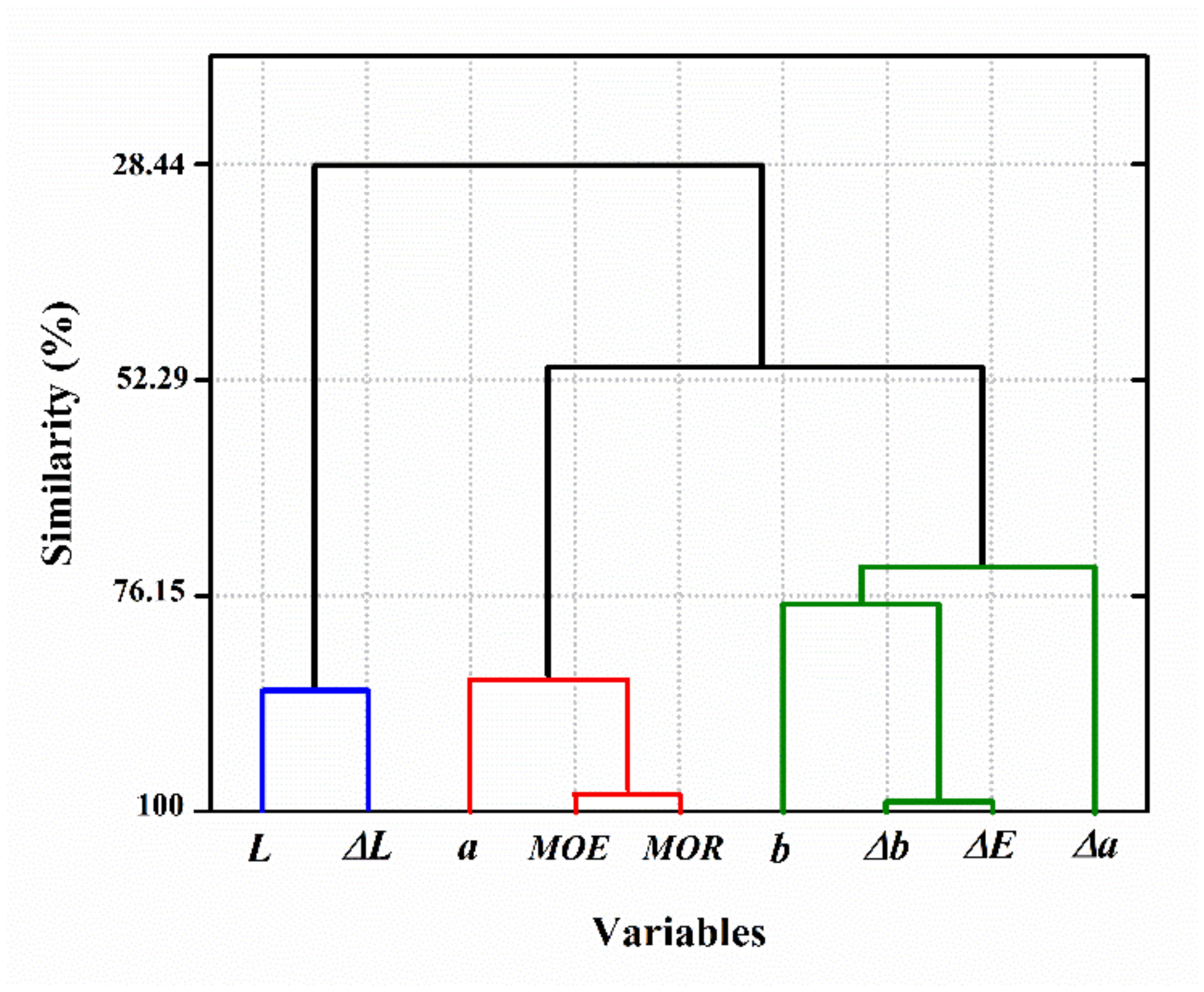
| Wood | Time (hrs) | ΔL | Δa | Δb | ΔE | ||||
|---|---|---|---|---|---|---|---|---|---|
| Mean | Std. | Mean | Std. | Mean | Std. | Mean | Std. | ||
| Fir | 24 | –1.39 a | 0.18 | –0.76 a | 0.13 | 7.66 a | 0.63 | 7.82 a | 0.66 |
| 100 | –11.51 b | 1.83 | –1.27 b | 0.18 | 15.42 b | 1.17 | 19.35 b | 0.95 | |
| 150 | –18.80 c | 2.74 | –0.35 c | 0.05 | 23.88 c | 1.79 | 30.42 c | 2.98 | |
| 240 | –25.01 d | 2.58 | 1.89 d | 0.14 | 19.26 d | 1.49 | 31.69 c | 1.72 | |
| Alder | 24 | –0.55 a | 0.12 | –0.31 a | 0.05 | 1.01 a | 0.17 | 1.19 a | 0.17 |
| 100 | –0.75 a | 0.18 | –1.35 b | 0.04 | 4.60 b | 1.00 | 4.86 b | 0.92 | |
| 150 | –1.63 b | 0.22 | –1.09 c | 0.07 | 5.52 b | 1.46 | 5.89 bc | 1.32 | |
| 240 | –4.19 c | 0.34 | –0.92 c | 0.09 | 5.39 b | 1.10 | 6.92 c | 0.84 | |
| Oak | 24 | –2.55 a | 0.39 | –0.07 a | 0.02 | 4.26 a | 1.30 | 5.02 a | 1.07 |
| 100 | –6.81 b | 1.06 | –0.71 b | 0.11 | 11.07 b | 1.69 | 13.06 b | 1.50 | |
| 150 | –9.20 bc | 1.60 | –0.03 a | 0.01 | 13.32 b | 2.16 | 16.22 b | 2.43 | |
| 240 | –11.50 c | 1.91 | 1.86 c | 0.37 | 9.97 b | 1.90 | 15.44 b | 1.64 | |
| Poplar | 24 | –2.26 a | 0.39 | –0.99 a | 0.15 | 3.67 a | 0.51 | 4.45 a | 0.31 |
| 100 | –5.11 a | 0.94 | –1.41 b | 0.19 | 11.66 b | 0.98 | 12.81 b | 1.26 | |
| 150 | –10.14 b | 1.86 | –0.27 c | 0.04 | 15.62 c | 1.42 | 18.72 c | 0.78 | |
| 240 | –13.75 c | 2.11 | 0.06 d | 0.01 | 14.58 c | 0.94 | 20.12 c | 0.95 | |
| Model Inputs | R2 | |||
|---|---|---|---|---|
| MOE | MOR | |||
| Train | Test | Train | Test | |
| Wood species, a, b, L | 0.92 | 0.84 | 0.81 | 0.77 |
| Wood species, a, b, L, ΔE | 0.92 | 0.87 | 0.93 | 0.88 |
| Wood species, a, b, L, ΔE, Δa, Δb, ΔL | 0.90 | 0.88 | 0.92 | 0.90 |
Publisher’s Note: MDPI stays neutral with regard to jurisdictional claims in published maps and institutional affiliations. |
© 2021 by the authors. Licensee MDPI, Basel, Switzerland. This article is an open access article distributed under the terms and conditions of the Creative Commons Attribution (CC BY) license (https://creativecommons.org/licenses/by/4.0/).
Share and Cite
Nasir, V.; Fathi, H.; Fallah, A.; Kazemirad, S.; Sassani, F.; Antov, P. Prediction of Mechanical Properties of Artificially Weathered Wood by Color Change and Machine Learning. Materials 2021, 14, 6314. https://doi.org/10.3390/ma14216314
Nasir V, Fathi H, Fallah A, Kazemirad S, Sassani F, Antov P. Prediction of Mechanical Properties of Artificially Weathered Wood by Color Change and Machine Learning. Materials. 2021; 14(21):6314. https://doi.org/10.3390/ma14216314
Chicago/Turabian StyleNasir, Vahid, Hamidreza Fathi, Arezoo Fallah, Siavash Kazemirad, Farrokh Sassani, and Petar Antov. 2021. "Prediction of Mechanical Properties of Artificially Weathered Wood by Color Change and Machine Learning" Materials 14, no. 21: 6314. https://doi.org/10.3390/ma14216314
APA StyleNasir, V., Fathi, H., Fallah, A., Kazemirad, S., Sassani, F., & Antov, P. (2021). Prediction of Mechanical Properties of Artificially Weathered Wood by Color Change and Machine Learning. Materials, 14(21), 6314. https://doi.org/10.3390/ma14216314







